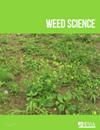碱Barnyardrass(Echinochloa crus galli var.Zelayensis)和Junglerice(Echinocloa colona)的种子生物学改良直播水稻管理
IF 2.1
2区 农林科学
Q2 AGRONOMY
引用次数: 1
摘要
碱禾草[Echinochloa cross -galli var. zelayensis (Kunth) Hitchc]和丛林草[Echinochloa colona (L.)][链接]是中国直播水稻(Oryza sativa L.)田间存在问题的一年生杂草。两种杂草的出苗生态学对环境因素的响应可能不同。采用室内和网棚试验,研究了光照、埋深、小麦残茬覆盖、淹水时间和淹水深度对南京两种杂草发生的影响。光照强烈地促进了种子的萌发。在黑暗条件下,荚膜荚膜荚膜种子萌发率(85%)高于荚膜荚膜荚膜荚膜荚膜(70%)。两种种子在土壤表面播种时的发芽率最高(十字花菜为90%,结肠为80%),出苗率随土壤埋深的增加而降低。埋深为2.2 cm和1.4 cm的大肠杆菌和大肠杆菌的出苗率分别降低了50%。在6 cm深度未发现羽化现象。在相同的土壤埋藏深度下,大肠杆菌的出苗率低于十字形大肠杆菌。小麦秸秆覆盖显著降低了两种植物的出苗率和地上生物量。麦渣覆盖对大肠杆菌的抑制作用明显强于对大肠杆菌的抑制作用。早期和深度淹水显著抑制了大肠杆菌和大肠杆菌的羽化、高度和生物量,尤其是大肠杆菌。本研究结果可为水稻直播系统中棘藻物种的管理提供基础生态学知识。本文章由计算机程序翻译,如有差异,请以英文原文为准。
Seed Biology of Alkali Barnyardgrass (Echinochloa crus-galli var. Zelayensis) and Junglerice (Echinochloa colona) for Improved Management in Direct-Seeded Rice
Abstract Alkali barnyardgrass [Echinochloa crus-galli var. zelayensis (Kunth) Hitchc] and junglerice [Echinochloa colona (L.) Link] are problematic annual weeds in direct-seeded rice (Oryza sativa L.) fields in China. The emergence ecology of the two weed species may differ in response to environmental factors. Laboratory and screenhouse experiments were conducted to evaluate the effects of light, burial depth, mulching with wheat (Triticum aestivum L.) residue, and time and depth of flooding on the emergence of the two weed species collected from Nanjing, China. Light strongly increased seed germination. Under dark conditions, E. crus-galli seed germination (85%) was higher than that of E. colona (70%). The seeds of both species exhibited the greatest germination (90% for E. crus-galli and 80% for E. colona) when sown on the soil surface, and emergence decreased with increasing soil burial depth. Burial depths of 2.2 and 1.4 cm reduced seedling emergence by 50% for E. crus-galli and E. colona, respectively. No emergence was found at a depth of 6 cm. The seedling emergence for E. colona was lower than for E. crus-galli at the same soil burial depth. Mulching with wheat residue considerably reduced the seedling emergence and aboveground biomass of both species. The inhibitory effect of mulching with wheat residue on E. colona was more notable than on E. crus-galli. Early and deep flooding significantly suppressed the emergence, height, and biomass of E. crus-galli and E. colona, especially E. colona. The results gained from this study could provide fundamental ecological knowledge for managing Echinochloa species in direct-seeded rice systems.
求助全文
通过发布文献求助,成功后即可免费获取论文全文。
去求助
来源期刊

Weed Science
农林科学-农艺学
CiteScore
4.60
自引率
12.00%
发文量
64
审稿时长
12-24 weeks
期刊介绍:
Weed Science publishes original research and scholarship in the form of peer-reviewed articles focused on fundamental research directly related to all aspects of weed science in agricultural systems. Topics for Weed Science include:
- the biology and ecology of weeds in agricultural, forestry, aquatic, turf, recreational, rights-of-way and other settings, genetics of weeds
- herbicide resistance, chemistry, biochemistry, physiology and molecular action of herbicides and plant growth regulators used to manage undesirable vegetation
- ecology of cropping and other agricultural systems as they relate to weed management
- biological and ecological aspects of weed control tools including biological agents, and herbicide resistant crops
- effect of weed management on soil, air and water.
 求助内容:
求助内容: 应助结果提醒方式:
应助结果提醒方式:


